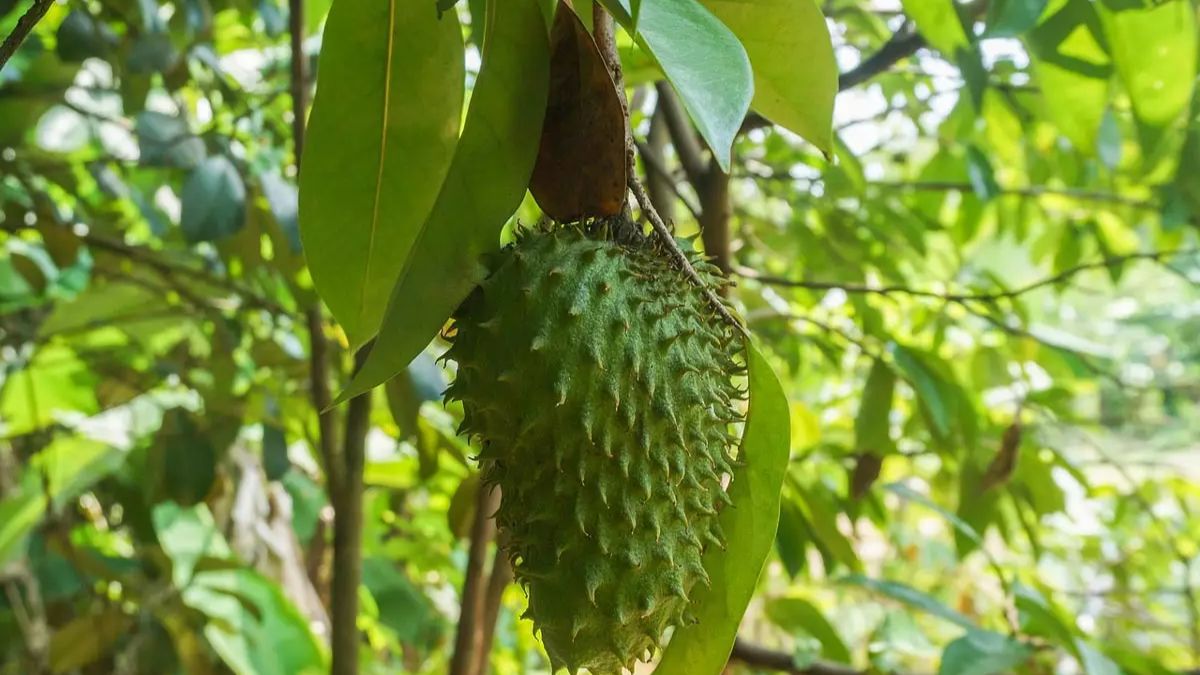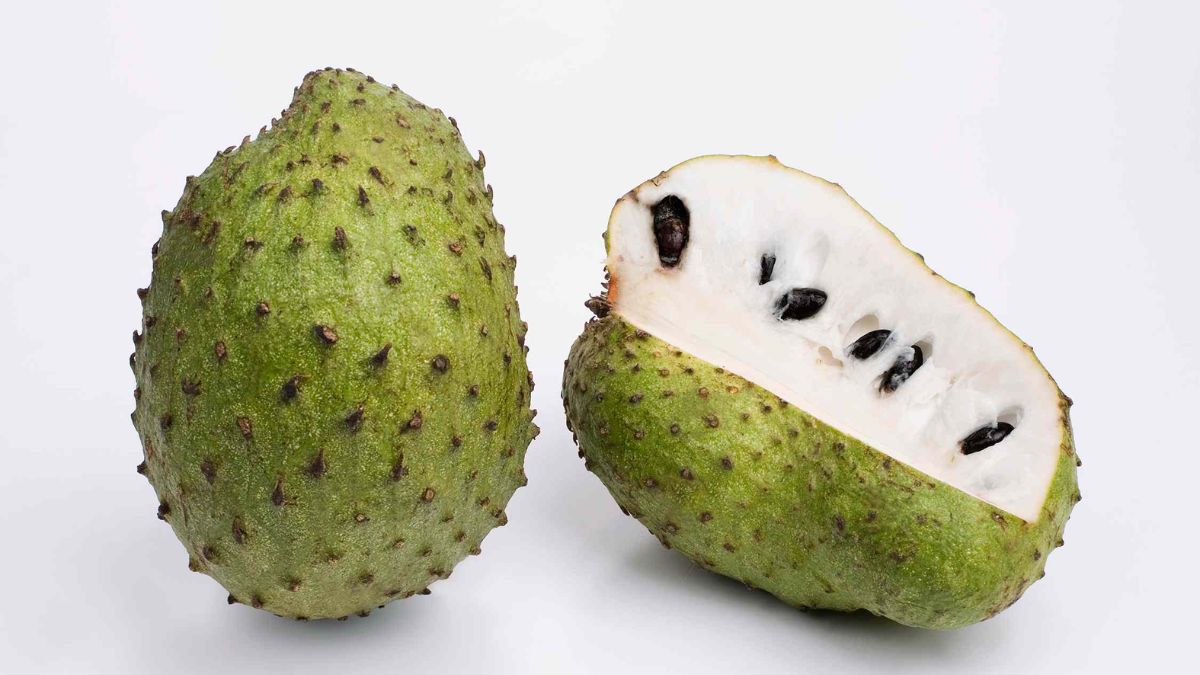The soursop fruit, which resembles a large strawberry crossed with an apple and sprouting thorns, is native to Central and South America and is a favourite sweet delicacy there. Soursop has a strawberry, pineapple, and citrus flavour to it. The fruit of the Annona muricata broadleaf evergreen, which belongs to the custard apple family, is known for its health advantages, including lowering inflammation, strengthening the immune system, and soothing stomach issues. Soursop is a tropical fruit endemic to the American tropics, guanabana, guyabano, Graviola, or Brazilian paw. It has a greenish-yellow tint, prickly skin, and creamy, white meat and grows on the Annona muricata tree.
A Soursop provides nearly 38 grams of carbs. Soursop contains more than 7 grams of fibre per serving, and its carbs come from naturally occurring sugars (about a quarter of your recommended daily intake). Soursop has a low glycemic index. Soursop, like most fruits, is a poor protein source. Only 2.3 grams of protein are found in a single serving. To achieve your daily protein needs, you’ll need to include other protein sources like salmon, lean meats, and legumes in your diet.
Soursop Nutrition Facts
What Is a Soursop?
Soursop, also known as custard apple, Graviola, or Brazilian paw, is the fruit of a tropical tree. It’s trendy in the West Indies and South America because of its tart flavour and rumoured medical powers. It has been documented if you can imagine an ailment that can be treated with Graviola. Diarrhea, digestive disorders, parasitic infections, diabetes, asthma, colds, arthritis, high blood pressure, fever, and anxiety have been reported to be helped by the fruit, juice, or teas produced from the tree’s leaves on which the fruit grows.
Raising the red flag of suspicion is acceptable when such a wide range of claims are made on behalf of one substance. The illnesses discussed have a range of causes, and it’s unlikely that they’ll all react to the same treatment. That is not how our bodies work. For example, asthma and diabetes are unrelated and require different treatments.
What Does Soursop Taste Like?
Its taste is often described as a combination of strawberry and apple, but with a bit of citrus mixed in. It’s most commonly found in Caribbean, South American, and Southeast Asian cuisines, where it’s used as an ingredient in beverages, syrups, and ice creams and eaten raw. Its name describes a portion of the flavour profile’s evolution. Soursop, like pineapple, goes through flavours from tart to sour to sweet in your mouth. The perfume of strawberries fills your senses all the time.
The velvety texture nicely coats all of these, creating a unique balance. The flavour has been compared to sour citrus, banana, coconut, mango, and other tropical fruits. We strongly advise you to try it for yourself to discover your memories of this tasty and versatile gift from Mother Nature.
What Are the Health Benefits of Soursop?
Soursop is contentious when it comes to its medical usage. There’s no denying that this tropical fruit makes some bold health claims, but detractors maintain that there are simply anecdotal data to back them up. Soursop has been found in limited test-tube tests to destroy some cancer cells potentially, but experts warn against using it to fight cancer because it hasn’t been researched in humans.
Soursop has been found in animal and test-tube experiments to lower blood sugar levels, reduce inflammation, and have antimicrobial characteristics and cancer-fighting claims. However, because these qualities have yet to be researched in people, it is impossible to say whether soursop is a viable alternative to traditional medicine. However, many other fruits are soursop tal in antioxidants and vitamin C, essential for maintaining a healthy immune system.
Potential for Cancer Prevention
According to a 2018 study, extracts from soursop fruit and the tree’s bark, roots, and leaves have the potential to treat cancer and non-malignant disorders.
However, there is insufficient human data to back up this claim. Cancer Treatment Centers of America experts advise against using soursop as a cancer fighter, noting that it is linked to many unproven claims. 5 Drugs derived from soursop plant chemicals are more likely to succeed than simply eating the fruit or drinking the tea made from its leaves.
Promotes Digestive Health
Soursop may help with digestion due to its high fibre content. The fruit juice can also work as a diuretic, eliminating excess sodium from the body and cleansing the gastrointestinal tract. In experimental animals, a soursop extract has been proven to aid in healing stomach ulcers.
Fights Inflammation
Like other fruits and vegetables, Soursop is high in antioxidants, which may aid in cell repair and inflammation reduction.
Where Can I Buy Soursop?
Soursop grows in some warmer parts of the United States, although it’s unlikely to be found in commercial supermarkets or big-box retailers. You’ll probably have to go to a foreign grocery store or market to find soursop. Next to other tropical fruits and vegetables, it’s in the produce area. Ripe soursop will be more yellow than green in colour and tender to the touch. It can be kept in the refrigerator for up to four days.
How to Cook and Eat Soursop?
Soursop is more commonly used in sweet than savoury recipes due to its sweet flavour and creamy texture (similar to a banana). Beverages, smoothies, and even ice cream are among them. Cut the soursop in half and scoop out the flesh with a spoon if you want to eat it raw (you’ll have to work around the seeds or spit them out as you go). Because of its stringy texture, soursop will be challenging to cut into cubes, necessitating a spoon to scoop it out.
Soursop is typically eaten raw, with the flesh scooped out after cutting the fruit in half. Because fruits vary in size and can be pretty enormous, it’s advisable to divide them into several portions. This fruit is low in calories but abundant in fibre and vitamin C in a typical serving. Ripe soursop can be cooked for eating, much like a vegetable. Soursop chunks or halves can be baked at 350 degrees Fahrenheit (176 degrees Celsius) for 20-30 minutes or until extremely mushy. Sprinkle the soursop with cinnamon or nutmeg before roasting to add even more flavour.
Conclusion
This is a nutritious fruit that, like other fruits, supplies essential vitamins and minerals when consumed. However, any extreme health claims, such as soursop’s alleged cancer-fighting abilities, cannot be substantiated without human testing. Soursop is not safe for humans as a supplement, food, or drink in excessive amounts, and I advise you to stay away from soursop supplements and tea. If you eat soursop pulp, desserts, or juice, restrict yourself to 12 cups twice a week.



